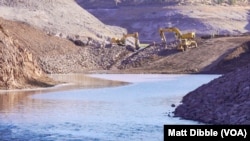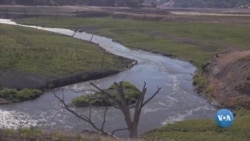ໃນພາກຕາເວັນຕົກສຽງເໜືອຂອງສະຫະລັດ, ໂຄງການຟື້ນຟູແມ່ນ້ຳທີ່ໃຫຍ່ທີ່ສຸດໃນໂລກໄດ້ທັບມ້າງເຂື່ອນໄຟຟ້າພະລັງງານນ້ຳອອກຈາກແມ່ນ້ຳຄລາແມັດ ເພື່ອຊ່ວຍປາແຊລມອນໃຫ້ພວກມັນໄດ້ອົບພະຍົບ. ໂຄງການນີ້ໄດ້ເຮັດໃຫ້ ທະເລສາບທີ່ຊຸມຊົນອ້ອມຂ້າງນີ້ຮັກແພງຕ້ອງຮູ້ສຶກຫວ່າງເປົ່າ. ນັກຂ່າວວີໂອເອ ແມັທ ດິບເບີລ (Matt Dibble) ໄດ້ເດີນທາງໄປທີ່ອະດີດທະເລສາບ ຄອບໂກ ເພື່ອເບິ່ງວ່າຜູ້ອາໄສຢູ່ນັ້ນເຂົາປັບໂຕກັນແນວໃດ. ພວກເຮົາມີລາຍລະອຽດມາສະເໜີທ່ານໃນອັນດັບຕໍ່ໄປ.
ທະເລສາບ ຄອບໂກ ຕັ້ງຢູ່ສູງໃນທະເລຊາຍຂອງພາກເເໜືອ ລັດຄາລິຟໍເນຍ, ເປັນອ່າງເກັບນ້ຳຍາວ 4.8 ກິໂລແມັດ ທີ່ສ້າງຂຶ້ນເມື່ອ 100 ປີກ່ອນ, ເມື່ອຕອນທີ່ມີການຕິດຕັ້ງເຂື່ອນໄຟຟ້າພະລັງງານນ້ຳເທິງແມ່ນ້ຳ ຄລາແມັດ ໃສ່.
ບໍ່ນ້ຳໃນທະເລຊາຍແຫ່ງນີ້ມີຊື່ສຽງມາແຕ່ດົນນານສຳລັບສັດປ່າ ແລະ ເປັນສະຖານທີ່ພັກຜ່ອນ, ແຕ່ສະຖານທີ່ເຫຼົ່ານີ້ໄດ້ປ່ຽນແປງໄປຢ່າງຫຼວງຫຼາຍ ເມື່ອຕົ້ນປີນີ້ ເມື່ອເຂື່ອນເຫຼົ່ານັ້ນຖືກຖອດຖອນອອກເພື່ອເປີດທາງໃຫ້ກັບປາ ໄດ້ອົບພະຍົບຜ່ານ.ແລະ ທະເລສາບໄດ້ຖືກລະບາຍນ້ຳອອກ
ການປ່ອຍແມ່ນ້ຳໃຫ້ເປັນອິດສະຫຼະ ເປັນເປົ້າໝາຍຂອງຊົນເຜົ່າ ຢູຣອກ ແລະ ຄາຣຸກ ລວມເຖິງກຸ່ມຊົນເຜົ່າພື້ນເມືອງໃນພື້ນທີ່ອື່ນໆ ມາຕັ້ງແຕ່ປາເຊລມອນ, ເຊິ່ງເປັນແຫຼ່ງອາຫານຫຼັກ, ເລີ່ມຖືກຄຸກຄາມໃນຫຼາຍທົດສະວັດທີ່ຜ່ານມາ.
ໃນຂະນະທີ່ແມ່ນ້ຳກຳລັງຟື້ນຟູຕົນເອງໃນເສັ້ນທາງເກົ່າ, ຜູ້ຢູ່ອາໄສໃນບ້ານ ປະມານ 100 ລັງຄາເຮືອນທີ່ ຄອບໂກ ກຳລັງພົບວ່າ ການປັບໂຕຂອງພວກ ເຂົານັ້ນເປັນຄວາມທ້າທາຍ.
ທ່ານນາງ ແພັດຕີ້ ວິນິໂຄ ໄດ້ຍ້າຍມາທີ່ນີ້ເມື່ອ 3 ປີກ່ອນ, ດ້ວຍແຮງດຶງດູດ ຈາກຄວາມງາມຂອງທຳມະຊາດ. ເຊັ່ນດຽວກັນກັບເພື່ອນບ້ານຫຼາຍໆຄົນ, ລາວ ຄັດຄ້ານການເອົາເຂື່ອນອອກ.
ທ່ານນາງ ແພັດຕີ້ ວິນິໂຄ, ຜູ້ຢູ່ອາໄສທີ່ທະເລສາບ ຄອບໂກກ່າວວ່າ
"ວິຖີຊີວິດທັງໝົດຂອງພວກເຮົາໄດ້ປ່ຽນແປງໄປເກືອບໝົດພາຍໃນຄືນດຽວ, ພາຍໃນສີ່ມື້."
ແລະ ມັນໄດ້ຖິ້ມຂີ້ຕົມ, ສັດທີ່ຕາຍໄວ້.
ກວາງ, ງົວ, ມ້າໄດ້ຕິດຢູ່ໃນຂີ້ຕົມ.
ທ່ານນາງ ແພັດຕີ້ ວິນິຄອຟ, ຜູ້ຢູ່ອາໄສທີ່ທະເລສາບ ຄອບໂກກ່າວວ່າ
“ພວກເຮົາທຸກຄົນຫວັງວ່າຈະມີການຟື້ນຟູທີ່ສວຍງາມພ້ອມຕົ້ນໄມ້ ແລະ ສັດປ່າກັບມາ. ຂ້ອຍບໍ່ຄິດວ່າຂ້ອຍຈະຢູ່ທີ່ນີ້ເພື່ອເຫັນສິ່ງທີ່ສວຍງາມເຫຼົ່ານັ້ນ ເພາະເຮົາໄດ້ຮັບແຈ້ງມາວ່າມັນຈະໃຊ້ເວລາຕັ້ງແຕ່ເຈັດຫາຊາວປີ."
ທ່ານນາງ ຄຣິດຊີ່ ເຣໂນລ ເຄີຍມາພັກຜ່ອນທີ່ນີ້ຕັ້ງແຕ່ຕອນຍັງນ້ອຍ, ຫຼັງຈາກນັ້ນກໍ່ຍ້າຍມາຢູ່ນີ້ແບບຖາວອນຕັ້ງແຕ່ປີ 1997.
ທ່ານນາງ ຄຣິດຊີ່ ເຣໂນລ, ຜູ້ຢູ່ອາໄສທີ່ທະເລສາບ ຄອບໂກກ່າວວ່າ
"ທຸກຄົນຈະມາໂຮມໂຕກັນ. ເຮົາຈະມັດເຮືອຂອງເຮົາ, ເຈົ້າຮູ້ບໍ່, ແລ້ວຈັດງານ ລ້ຽງອາຫານຄ່ຳຢູ່ກາງທະເລສາບ. ເຮົາຈະມີງານຈືນປາອີກດ້ວຍ.
ຮ້ານຄ້າ ທະເລສາບ ຄອບໂກ ທີ່ປິດແລ້ວໃນຕອນນີ້, ແລະ ສູນຊຸມຊົນຢູ່ກົງ ກັນຂ້າມຫົນທາງ, ເຄີຍເປັນສູນກາງຂອງຊຸມຊົນ.
ທ່ານນາງ ຄຣິດຊີ່ ເຣໂນລ, ຜູ້ຢູ່ອາໄສທີ່ທະເລສາບ ຄອບໂກກ່າວວ່າ
"ພວກເຮົາເປັນຊຸມຊົນທີ່ຜູກພັນ/ຮັກແພງກັນຫຼາຍ ແລະ ການເຫັນການປ່ຽນ ແປງທັງໝົດນີ້ເກີດຂຶ້ນໄວຫຼາຍແບບນີ້ ມັນເຮັດໃຫ້ຮູ້ສຶກເສຍໃຈຫຼາຍແທ້ໆ.
ທ່ານ ຟຣານຊີສ ກິວ ແລະ ຜົວຂອງລາວ ທ່ານ ແດນນີ່ ຟອນເທນ ໄດ້ຢູ່ທີ່ ສູນກາງຂອງຊຸມຊົນ ຄອບໂກ, ບ່ອນທີ່ ທ່ານ ກິວ ເຄີຍເປັນຜູ້ນຳໜ່ວຍດັບ ເພີງອາສາສະໝັກມາ 19 ປີ.
ພວກເຂົາເຄີຍເປັນຜູ້ຄັດຄ້ານທີ່ໂດດເດັ່ນໃນການເອົາເຂື່ອນອອກ ແຕ່ຕອນນີ້ ກຳລັງເຂົ້າໃຈ ແລະ ຍອມຮັບໃນການປ່ຽນແປງໃນຄັ້ງນີ້.
ທ່ານ ຟຣານຊີສ ກິວ, ຜູ້ຢູ່ອາໄສທີ່ທະເລສາບ ຄອບໂກກ່າວວ່າ
"ຂ້ອຍຈະຄິດຮອດທະເລສາບຫຼາຍຢ່າງແນ່ນອນ, ແຕ່ແມ່ນ້ຳກໍ່ໜ້າປະທັບໃຈ ແລະ ຂ້ອຍເຫັນສັກກະຍະພາບຂອງຄວາມງາມໃນອະນາຄົດ."
ແຕ່ການສູນເສຍທະເລສາບໄດ້ຂັດຂວາງແຜນການຂອງຄູ່ຮັກຄູ່ນີ້ທີ່ຈະເປີດຮ້ານຄ້າ ຄອບໂກ ອີກຄັ້ງ.
ທ່ານ ແດນນີ່ ຟອນເທນ, ຜູ້ຢູ່ອາໄສທີ່ທະເລສາບ ຄອບໂກກ່າວວ່າ
"ຕໍ່ກັບທຸກສິ່ງທີ່ເກີດຂຶ້ນ, ເຮົາພຽງແຕ່ຮູ້ສຶກວ່າມັນບໍ່ແມ່ນຄວາມຄິດທີ່ດີເລີຍ."
ຕອນນີ້ພວກເຂົາໃຫ້ເຊົ່າອາຄານກັບຊົນເຜົ່າ ຢູຣອກ ທີ່ໃຊ້ເປັນສຳນັກງານ ສຳລັບຄົນງານທີ່ກ່ຽວຂ້ອງກັບຄວາມພະຍາຍາມທີ່ຈະຟື້ນຟູແມ່ນ້ຳ.
ເຖິງແມ່ນວ່າຈະເຄີຍຢູ່ຝ່າຍກົງກັນຂ້າມກັນ ໃນບັນຫາການເອົາເຂື່ອນອອກ, ຊົນເຜົ່າກໍ່ໄດ້ຮັບການຕ້ອນຮັບທີ່ນີ້, ຢ່າງໜ້ອຍກໍ່ໄດ້ຮັບຈາກ ທ່ານ ກິວ ແລະ ທ່ານ ຟອນແທນ.
ທ່ານ ແດນນີ່ ຟອນແທນ, ຜູ້ຢູ່ອາໄສທີ່ທະເລສາບ ຄອບໂກກ່າວວ່າ
"ພວກເຂົາຍັງຈັດງານໂຮມໂຕກັນຢູ່ທີ່ນີ້ກັບພະນັກງານຫຼາຍຄົນ ແລະ ຕັ້ງແຄ້ມ ເທິງເດີ່ນຫຍ້າ ຂ້ອຍກັບຟຣານຊີສ ໄດ້ຈັດຄາຣະໂອເກະໃຫ້ພວກເຂົາທີ່ນີ້ ແລະ ພວກເຮົາກໍພາກັນມ່ວນຫຼາຍ."
ເຊັ່ນດຽວກັບການຟື້ນຟູທຳມະຊາດ, ການຟື້ນຟູຊຸມຊົນຈະຕ້ອງໃຊ້ເວລາ, ແຕ່ກໍ່ມີສັນຍານທີ່ໜ້າສົນໃຈບາງຢ່າງ.
ອ່ານຂ່າວນີ້ໃນພາສາອັງກິດ
In the Pacific Northwest, the world’s largest river restoration project has removed hydroelectric dams from the Klamath River to help migrating salmon. The project emptied a lake beloved to its surrounding community. VOA's Matt Dibble went to the former Copco Lake to see how residents are adjusting.
Copco Lake was located in the high desert of northern California, a 4.8-kilometer-long reservoir created more than 100 years ago when hydroelectric dams were installed on the Klamath River.
An oasis long popular for its wildlife and recreation, the scene changed dramatically earlier this year when those dams were removed to allow passage for migratory fish.
Freeing the river has been a goal of the Yurok and Karuk tribes and other area indigenous groups ever since salmon, a primary food source, became threatened decades ago.
As the river re-establishes itself in its old course, many of those living in the 100 or so homes at Copco are finding their adjustment challenging.
Patty Vinikow moved here three years ago, drawn by the natural beauty. Like many of her neighbors, she opposed the dam removal.
((Patty Vinikow, Copco Lake Resident))
"Our whole way of life has changed almost literally overnight, within four days.
And it left mud, dead animals.
Deer, cows, horses caught in the mud.
((Patty Vinikow, Copco Lake Resident))
We all hope for a wonderful recovery with trees and wildlife back. I don't think I'll be here to enjoy that benefit because we were told it would be from seven to 20 years."
Chrissie Reynolds enjoyed vacations here as a child, then moved here full time in 1997.
((Chrissie Reynolds, Copco Lake Resident))
"Everybody would gather. We would tie up our boats, you know, and have dinner parties out on the lake. We would have fish fries.
The Copco Lake Store, now closed, and the community center across the street, were the hubs.
((Chrissie Reynolds, Copco Lake Resident))
"We are a very tight-knit community and to see all these changes so quickly has been really heartbreaking."
Francis Gill and his husband, Danny Fontaine, are at the center of the Copco community, where Gill led the volunteer fire department for 19 years.
They were prominent opponents of dam removal but are now making peace with the change.
((Francis Gill, Copco Lake Resident))
"I definitely miss the lake, but the river is fascinating, and I can see the potential for the beauty in it in the future."
But loss of the lake has hindered the couple's plans to re-open the Copco Store.
((Danny Fontaine, Copco Lake Resident))
"With all of this, we just don't feel like it's a good idea."
Now they are leasing the building to the Yurok Tribe who use it as an office for workers involved in the river restoration effort.
Once on opposing sides of the dam removal issue, the tribe has been welcomed here, at least by Gill and Fontaine.
((Danny Fontaine, Copco Lake Resident))
"They even had a get-together out here with a lot of their employees and camped out on the lawn and me and Francis put on karaoke for them out here and we had a great time with them."
Like the natural restoration, the community restoration will take time, but there are some promising signs.







ຟໍຣັມສະແດງຄວາມຄິດເຫັນ